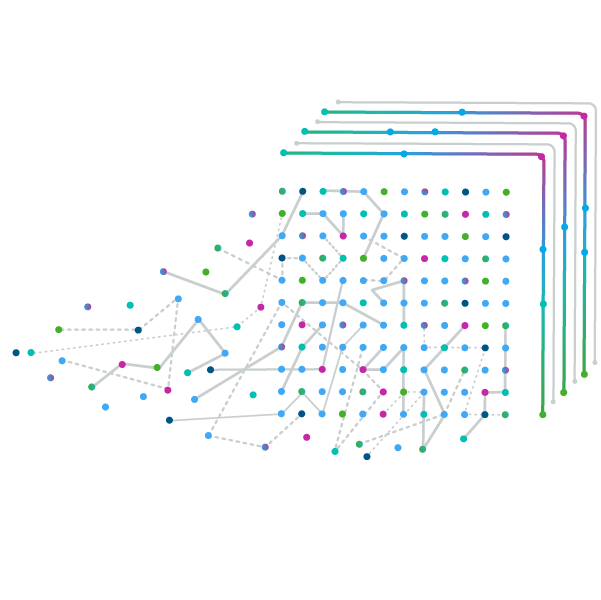Our webinar Exploring Real World Data in the United States provided crucial insights into the data landscape with profiles of some of the most useful data assets available.
Understanding the Unique Landscape of U.S. Healthcare
One of the most impactful aspects of the US patient data landscape is the lack of universal healthcare coverage, producing a complex interplay of public and private sector regulations. In the US, most individuals receive healthcare through employer-backed plans, creating a patchwork of coverage options.
How Claims, EMR, AIML Unlock New Insights
Importantly, Real World Data (RWD) plays a crucial role in informing healthcare practices and policies, helping stakeholders navigate this rich environment.
The webinar, part of our global data insight series, highlighted the US healthcare data environment, including key data assets and dataset types. It showed how to get a complete view of the patient journey with PharMetrics® Plus, how to explore detailed patient clinical information with Ambulatory Electronic Medical Records (EMR) data, and how to develop a deep understanding of patient populations and treatment dynamics for their selected therapies with open claims. In addition, the webinar examined how AIML can unlock opportunities to improve patient care and commercial performance.
The Role of Real World Data in Preventative Healthcare
Prevention is a cornerstone of U.S. healthcare, with services such as annual screenings and well visits often provided at no cost to patients. This preventive approach is informed by Real World Data, which allows healthcare providers to analyze trends and outcomes associated with different interventions. By understanding disease characteristics and progression through RWD, healthcare professionals can enhance treatment patterns, establish effective safety protocols, and improve overall patient outcomes.
Adapting to Change: Telehealth and Real World Data
The COVID-19 pandemic accelerated the adoption of telehealth, a delivery method that has gained popularity for its convenience. This evolution in service delivery is backed by Real World Data, which helps assess the effectiveness of telehealth in providing quality care. RWD allows researchers and clinicians to evaluate how well telehealth meets patient needs, ensuring that health services adapt to the changing preferences of the population.
Regulatory Framework: HIPAA and Patient Privacy
An essential component of the U.S. healthcare system is the Health Insurance Portability and Accountability Act (HIPAA), which safeguards patient privacy. This regulatory framework intersects with the use of Real World Data, as healthcare professionals must ensure that patient information is handled with the utmost confidentiality. Understanding how RWD can be utilized within these legal parameters is vital for maintaining trust and compliance in healthcare research and practice.
Leveraging Real World Evidence for Research
Real World Evidence (RWE) is derived from the analysis of Real World Data and is instrumental in answering many crucial research questions. RWE helps elucidate disease characteristics, including comorbid conditions, leading to enhanced treatment patterns and improved patient safety. By using RWE, healthcare stakeholders can make informed decisions that ultimately result in better health outcomes for patients.
PharMetrics® Plus: A Comprehensive Data Source
IQVIA’s PharMetrics Plus dataset represents a significant advancement in the collection of RWD. This closed-claims database encompasses integrated medical and pharmacy claims from various health plans across the U.S. By capturing a complete view of patient journeys, RWD from PharMetrics Plus allows researchers to analyze healthcare utilization patterns, making it an asset for understanding treatment efficacy and safety.
The Power of Linking Data Sources
The ability to link different sources of Real World Data significantly enhances the depth of analysis. For example, linking closed claims data to electronic medical records (EMR) can provide insights into patient demographics, lab results, and treatment histories. This comprehensive approach enables researchers to gain a deeper understanding of patient care trajectories, leading to more effective interventions and improved patient outcomes.
Exploring Ambulatory EMR as a Data Source
Ambulatory EMR data further enriches the landscape of Real World Data. This dataset captures patient interactions across outpatient settings, offering clinically rich information such as diagnoses, prescriptions, and vital signs. The longitudinal nature of this data allows for a comprehensive view of patient care over time, highlighting how treatments and patient outcomes evolve. RWE derived from Ambulatory EMR is crucial for identifying trends and guiding clinical practices.
Overcoming Challenges in Real World Data Utilization
While the potential of Real World Data and Real World Evidence is immense, challenges remain. Issues such as data quality, standardization, and patient privacy must be addressed to fully leverage RWD in healthcare decision-making. Ensuring that methodologies for analyzing RWD are robust is essential for yielding reliable findings that can inform clinical practice and policy.
The Future of Real World Data and Evidence
The integration of Real World Data and Real World Evidence is playing an increasingly important role in shaping the U.S. healthcare system. By harnessing RWD, stakeholders are able to make informed decisions that lead to improved patient outcomes and more effective healthcare practices.
As the healthcare landscape continues to evolve, the importance of RWD and RWE will only grow, driving advancements in care delivery and ensuring that patient needs remain at the forefront of healthcare innovation. Embracing these tools will be critical for navigating the complexities of modern healthcare and achieving better health outcomes for all.
Leveraging Real World Data with AI and ML for Pharmaceutical Success
In today's fast-paced pharmaceutical landscape, brands face unprecedented challenges and opportunities driven by the explosion of Real World Data (RWD). With the growing volume and complexity of this data, the integration of Artificial Intelligence (AI) and Machine Learning (ML) has become crucial in extracting actionable insights that drive commercial success. This article explores the multifaceted applications of AI and ML in leveraging RWD to enhance patient outcomes and optimize brand strategies.
The Importance of Artificial Intelligence and Machine Learning in Pharma
The confluence of abundant data and advanced analytics tools has made AI and ML indispensable for pharmaceutical companies. As these technologies evolve, they enable brands to glean deeper insights and engage more effectively with healthcare professionals (HCPs) and patients alike. The ability to turn complex datasets into clear, actionable strategies is vital for brands aiming to enhance their market position.
Key Use Cases
The webinar provided several use case examples of leveraging US RWD to benefit healthcare companies and patients alike:
- Optimizing Commercial Activities: AI and Machine Learning play a pivotal role in refining commercial efforts, enhancing HCP targeting, and improving audience quality in digital campaigns. By employing predictive models, companies can identify HCPs likely to adopt new therapies, thereby maximizing promotional efficiency.
- Supporting Clinical Decision-Making: Deploying algorithms in clinical decision support tools can significantly impact patient care. Ongoing pilots aim to utilize AI-driven insights at the point of care, ensuring that patients receive timely and appropriate treatments.
- Accelerating Patient Benefit: The ultimate goal of using AI and ML is to improve patient outcomes. For instance, identifying patients with rare diseases early can lead to quicker diagnoses and timely interventions.
Core Offerings Powered by Real World Data
The use of Real World Data is foundational in several key offerings designed to optimize patient engagement and HCP targeting:
- Predictive Patient Finding and Disease Modelling: This foundational module harnesses AI and ML to identify potential patient populations before they seek treatment. By analyzing patterns within existing patient data, brands can proactively engage with HCPs and patients who may benefit from their therapies.
- Patient Characterization and Journey Analysis: Utilizing claims data within a self-service platform enables quick insights into patient demographics, treatment journeys, and potential barriers to care. This module empowers brands to tailor their strategies based on nuanced patient profiles.
- Dynamic HCP Profiling and Targeting: By integrating claims data with real-time analytics, brands can create highly targeted lists of HCPs who are best positioned to support specific patient populations, ensuring more focused promotional efforts.
- Real-Time Field Alerts for Optimized Performance: This innovative feature generates dynamic target lists based on ongoing data analysis, allowing sales teams to respond quickly to emerging patient needs and market trends.
Enhancing Patient Finding with Advanced Analytics
The patient finding process utilizes known data events to uncover lookalike patients or physicians, enhancing market segmentation and targeting. For instance, by identifying patients who exhibit similar characteristics to known cases, brands can more effectively pinpoint potential new patients who may benefit from their therapies. This proactive engagement is particularly crucial for rare diseases, where early identification can significantly impact treatment outcomes.
Case Study: Rare Kidney Condition
A compelling example involves a pharmaceutical client launching a new treatment for a rare kidney condition. Without specific ICD codes or prescription data, identifying target prescribers was challenging. By analyzing EMR data and modeling patient profiles, the team successfully generated a target list with a remarkable 30% precision rate. This approach allowed for targeted field deployment at launch, highlighting the effectiveness of AI and ML in navigating complex data landscapes.
Streamlining Insights with Advanced Tools
The introduction of applications such as the Patient Journey and Characterization App and the HCP Profiling App enhances the speed and depth of insights available to clients. These tools facilitate real-time data refreshes and provide comprehensive metrics, allowing for more agile strategic planning and market responsiveness.
Accelerated Insight Delivery
Traditionally, in-depth analyses could take weeks to complete. However, these new platforms enable rapid deployment, reducing timelines to mere days. This shift allows pharmaceutical companies to adapt to changing market conditions and patient needs much more effectively.
Real-Time Targeting and Alerts
The integration of AI and ML also enhances real-time targeting through automated field alerts. By identifying events of interest within the data, brands can swiftly connect with HCPs managing patients who are likely to transition therapies or require new treatments. This capability not only improves engagement but also supports timely interventions that can lead to better patient outcomes.
Case Study: Head and Neck Cancer
A notable success involved a program aimed at predicting patient progression in head and neck cancer. By employing AI models, the client achieved a 25% increase in patient engagement and an estimated ROI of $6 million within five months. This case underscores the transformative potential of AI-driven insights in driving brand success.
Conclusion and Summary
The convergence of Real World Data with AI and ML is revolutionizing the pharmaceutical industry. By harnessing these technologies, brands can proactively engage patients, refine their targeting strategies, and ultimately improve health outcomes. As the landscape continues to evolve, the ability to leverage data-driven insights will be paramount for sustained commercial success in the pharmaceutical sector.
Episode 8 of our Health Data Passport Webinar series took us to the United States to discover how its robust, linkable Real World Data improves patient outcomes and uncovers dynamic commercial insights. Insightful takeaways included:
- How to examine treatment patterns and healthcare costs with PharMetrics Plus data
- How to identify hard-to-find patients with rare diseases or disease subtypes with Ambulatory EMR data
- How to uncover market sizing, targeting and product usage insights with open claims
- How to leverage the power of artificial intelligence (AI) and machine learning (ML) to identify potential patients and HCPs
For more about these topics, and how US patient data and available IQVIA technologies can accelerate your next project, watch the webinar replay of Exploring Real World Data in the United States. or contact us for a meeting.
You may also be interested in
IQVIA Health Data Catalog Infographics
Get a detailed overview of available datasets in Health Data Catalog.
Accelerating Multi-Country Research with OMOP Data and the Health Data Passport Webinar Series
A summary of Episode 7 of our Global Real World Data webinar series


























